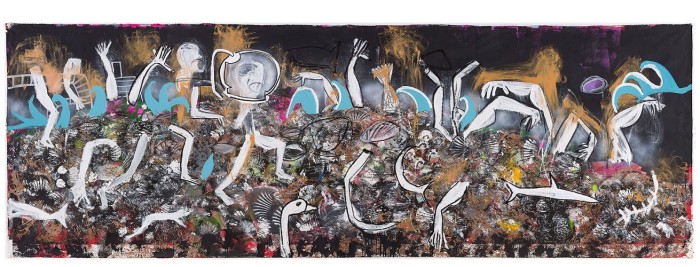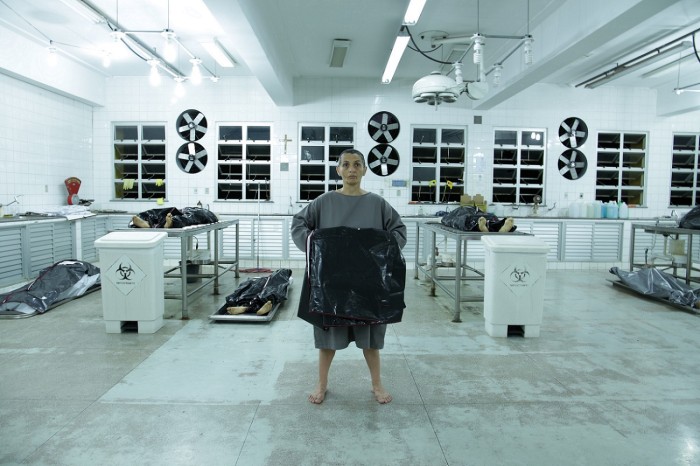Tiempo de lectura: 8 minutos

31.01.2016
Museu de Arte Moderna de São Paulo, São Paulo, Brazil
3 de octubre de 2015 – 10 de febrero de 2016



To highlight the first three-dimensional artistic manifestations we know of, produced between 4,000 and 1,000 years b.C. in the territory that today is Brazil and to propose experimentations about how they can dialogue with national contemporary production. This is the motto of the 34º Panorama da Arte Brasileira – da pedra da terra daqui, a biennial show at the Museu de Arte Moderna de São Paulo, curated by Aracy Amaral with assistant curator Paulo Miyada and with archeologist prof. André Prous as consultant. In order to draw a parallel between these pre-historical sculptures found in a territory extending from today’s Brazil Southeast and Uruguay and to propose a modern dialogue, the curators invited Berna Reale, Cao Guimarães, Cildo Meireles, Erika Verzutti, Miguel Rio Branco and Pitágoras Lopes – six artists from different generations and areas, with contrasting artistic research. These artists who were selected produce works representing Brazil’s complexities and exhibited side by side with about 60 different polished stone lithic sculptures, for the first time as part of a large exhibition joining past and present, sharpening debates about Brazilian art.
The curators’ idea is to work on issues of territory, landscape, and passing of time, transforming these archeological sculptures into a linking core for the exhibition. The artists are interlocutors of ancestry as they show relationships established between past and present through the works created exclusively for this exhibition and created in different media such as video, sculpture, photography, painting and installation. The results of the works reveal visceral, telluric contents, as well as eventual affinity with the pre-historic artifacts. “These preciosities from our remote antiquity are indisputably of high technical skill, formal ingenuity, and style cohesion,” curator Aracy Amaral explains.
The 34º Panorama da Arte Brasileira – da pedra da terra daqui is an opportunity to project a poetic, visual horizon of peoples who dealt with the passing of time in a different way compared to the – sometimes exploitative, sometimes developmental – attitude predominating in Brazil’s occupation since colonial times to this day. According to studies, the pre-historical pieces had religious and ritualistic usages and were found in sambaquis (man-made shell mounds) built thousands of years ago by successive generations of coastal populations called sambaquieiros (shell mound-builder) peoples. “The shell mounds form a powerful image of how to build deep relationships with ideas of ancestry, landscape and time, unfortunately treated with indifference by most Brazilian scientists and artists, a symptom of a lack of attention we pay to out own history,” Paulo Miyada comments.
The Great Room shows two aspects: the first axis comprises approximately 60 stone pieces in displays positioned along the lenght of the room. Most of these sculptures are made of magmatic rocks, called diabases, and they were produced by polishing and cleaving the stones with the aid of water and sand, and sometimes they were sharpened with the aid of abrasive stones. The stone pieces come from various institutions, such as the Museu de Arqueologia e Etnologia da USP; Museu Nacional da UFRJ; Instituto de Ciências Humanas da UFPEL; Museu Arqueológico de Sambaqui de Joinville (MASJ); Museu de Arqueologia e Etnologia (MArquE) da UFSC; Museu de Arqueologia e Etnologia (MAE) da UFPR; Museu do Homem do Sambaqui, of Florianópolis; besides the Div. Museos y Patrimonio Dpto. Cultura and the Museo de Arte Precolombino e Indígena (MAPI), both from Uruguay.
The other part of the exhibition contemplates works created exclusively for this edition of Panorama, presented in an order alluding to distant past and bringing visitors gradually back to present time. To introduce visitors to the universe of the shell mound-builder peoples, the first work exhibited is by Cao Guimarães, from Minas Gerais state, who was invited to travel to Santa Catarina state coast to check the places where shell mounds existed. Under an overpass in the city of Florianópolis, Cao discovered soil covered in shells, oysters and cockles. It was not a shell mound surrounded by recent urbanization, but a plot occupied by works who spend their days separating mollusks from their valves. The artist created a kind of fabulation about the place and its relationship with time and landscape. Current images were articulated on a video going through different times in that location, added to archiva footage of Mexican monuments that, together, form a 15-minute video essay connecting the issue of territory, transforming space and passing of time into poetry.
Miguel Rio Branco, known for synestheticslly working painting, photo and video and for dealing with issues regarding the Brazilian territory without sticking to classifications, presents an installation involving rocks, rubble, plants and television sets. In a closed, full of light room, the artist creates constructed ruins, alluding to a greenhouse, showing how nature wants to reclaim back its place and he produces disquieting thoughts about the future of the planet after a likely disappearance of humans. On the TV sets, a series of photographs illustrating fragments of old, broken, abandoned, dirty towns. The project is an immersive version showing a path to be followed approaching memory, thought, and transformation processes. “In other words, this new work reinforces the show’s enigmatic character, bringing parts of what belongs to the territory. In this case, framed as a zone of decay, filth, tension, relax, and inexplicable beauty,” Miyada explains.
Cildo Meireles, one of the most important Brazilian artists, who is acknowledged worldwide for dealing with issues of territory, history, politics, and memory, brings an oneiric and symbolic work. For this exhibition, Cildo has made Fronteiras Verticais (Vertical Frontiers), one of the projects of the Arte Física (Physical Art) series, which was conceived in 1969, when the artist was 21 years old. The work consists of making the highest point of the country’s territory to go up a few centimeters with the aid of a small piece of kimberlite rock placed on the top of the Pico da Neblina, the highest point of Brazil, located in the North of the Amazon, close to the Venezuela border, measuring 2.994 meters high. The artist addresses the issue of the territory by accomplishing this project, which only existed as a drawing up until now. To make this work possible, the artist was helped in a two week expedition by the yanomamis, the local people that is responsible for the territory comprising the Pico da Neblina. The artist respected the place, which is sacred to the yanomami people, and therefore he only fixed a small stone on the top of the mountian without damaging the spot. This project had the collaboration of the artist Édouard Fraipont and his assistent Miguel Escobar, and it is presented by means of a film, of plans, documents and photos of the expedition.
The youngest among selected artists, Erika Verzutti, from São Paulo, belongs to a more recent generation, but recognized by critics. As a sculptor, Erika’s work is hard to define because it is more intuitive, although filled with historic, artistic or design references. When she invents, mixes and shuffles, the artist creates simple forms that can outline a comparison relationship to the zoolites through shape affinity, size and similarity. The key piece for the exhibition is one of her “cemeteries,” works she realizes throughout the year that do not work or are not used. These abandoned pieces are then accumulated and gathered in one, creating a great work that has notable relationships with the shell mounds and with funerary symbols reflecting on the passing of time and they show an evident relationship with ancestral issues.
Pitágoras Lopes presents eight large format canvases between abstract and figurative styles, mixing stains, doodles, and textures. A painter compulsively producing art, Pitágoras spent months working for the show and using sand and dirt colors, navy blues and strokes that make one thinks of rock painting records and silhouettes analog to the pieces from the shell mounds, as well as shells, seas, and hills. This artist from Goiânia has a mix of references and drinks from the waters of street painting, pop culture and illustration, but cannot be classified within any of these styles. “Pitágoras’s visual production entails a kind of cosmology in which attentive observation of a marginal daily life converges with fantasy and delirium,” Miyada exemplifies.
Finally, Berna Reale, from Pará state, an artist commited to the present and to the country’s social issues, presents two works that finalize the exhibition’s flow and, at the same time, bring visitors back to the present. The first is a video illustrating corruption and violence by mixing politicians dressed in ties to fatal victims of urban violence. The second work is an installation in a closed, dark room simulating a low class dance club, where the sounds are sirens and noises typical of a police car and the illumination is red and blue emergency lights filtered by a screen fixed on the ceiling and perforated by various caliber gunpoint shots. The installation comprises dishes with meringues offered for free in the middle of the room, contrasting with the heavy and tense atmosphere. “Berna Reale’s art always responds to the question “What may be art’s purpose? Art serves to be together with conflicts of its time. Not to solve them, not to teach something about then or to erase them, but, on the contrary, to make them present, visible, and rough,” the curator concludes.
Photo: Karem Kilim, Romulo Fialdini, Sebastiano Pellion di Persano, Eduardo Ortega, Paulo Rezende, Edouard Fraipont, Manuella Reale
Courtesy of Museu de Arte Moderna de São Paulo
Comentarios
No hay comentarios disponibles.